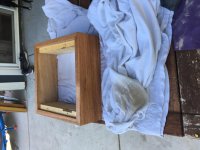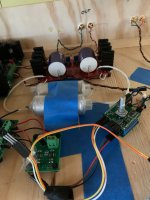Looks great BRN, I really like the outcome. Reminds me that I have a Bottlehead S.E.X amp
That's been neglected...
That's been neglected...
Ventilation is a good call. The base does have feet to allow air to flow under it, but adding vent to the top will only help.
The caps are Panasonic EZP-E 10uF that I purchase for another build, but never used. So far they sound good, but at the moment my hearing is jacked up. I had a procedure on my left ear and can't heat s#!t out of it.
I am working on something similar. Just applied the first coat of tung oil. The hot air gets trapped without vent holes.
Attachments
Thanks for posting that.
I briefly considered doing something like that though the trial and error and the sourcing seemed like more of a pita than I wanted to bother. Having a drawing and a bom makes this very appealing.
I briefly considered doing something like that though the trial and error and the sourcing seemed like more of a pita than I wanted to bother. Having a drawing and a bom makes this very appealing.
C3 fancy Mundorf caps...
Hi friends
I have one of those 🙄-questions...
I'll use some Mundorf EVO at C3, they're the white ones with red print on them.
They come with one leg short, the other long. Probably the long leg indicates the outer foil?
I know they're not polarized and could be placed either way. But is there a "more correct" way, like, long leg closer to the bypass-C3?
Thank you, enjoy Sunday!
d.)
Hi friends
I have one of those 🙄-questions...
I'll use some Mundorf EVO at C3, they're the white ones with red print on them.
They come with one leg short, the other long. Probably the long leg indicates the outer foil?
I know they're not polarized and could be placed either way. But is there a "more correct" way, like, long leg closer to the bypass-C3?
Thank you, enjoy Sunday!
d.)
I got some of those Mundorfs measured and it seems to be consistently the short leg, that is connected to the outer foil. They also say so on der web page:
MCap SUPREME EVO Oil | Mundorf EB GmbH
Asked myself the same question and connected the outer foil towards the 332R shunt resistor (facing towards the trim pots). Wisdom has it that one should connect the outer foil to the lowest impedance to ground so noise can easier be shunted. Recently I slapped some FT-3 teflon bypass caps on mine and didn´t care much as those are in a metal housing.
Of course I could be wrong but that´s at least how I did it.
Have great day
MCap SUPREME EVO Oil | Mundorf EB GmbH
Asked myself the same question and connected the outer foil towards the 332R shunt resistor (facing towards the trim pots). Wisdom has it that one should connect the outer foil to the lowest impedance to ground so noise can easier be shunted. Recently I slapped some FT-3 teflon bypass caps on mine and didn´t care much as those are in a metal housing.
Of course I could be wrong but that´s at least how I did it.
Have great day

Last edited:
Amusing video:
YouTube: Are Your Capacitors Installed Backwards? Build this and find out
... although I think the gizmo would be 5% more useful if the left and right LEDs were different colors. Just another clue to help the human operator remember which end was low-amplitude. Memory needs to remain correct and active, during the 5 second pause when he looks for the marking pen, picks it up, and moves to make a dot or line or 5 pointed star, on the just discovered "Outside" terminal end.
_
YouTube: Are Your Capacitors Installed Backwards? Build this and find out
... although I think the gizmo would be 5% more useful if the left and right LEDs were different colors. Just another clue to help the human operator remember which end was low-amplitude. Memory needs to remain correct and active, during the 5 second pause when he looks for the marking pen, picks it up, and moves to make a dot or line or 5 pointed star, on the just discovered "Outside" terminal end.
_
Last edited:
Thank you Mark! Yet another probably quite well pointed out feature out of your ∞-1 library/knowledge!
Mr Carlson is fabulous anyway. Upped to top in the playlist (Having difficulties to unbury 45‘ to watch this vid right now… suspect an unsurprising result? …)
Mr Carlson is fabulous anyway. Upped to top in the playlist (Having difficulties to unbury 45‘ to watch this vid right now… suspect an unsurprising result? …)
And a follow-up, hopefully little more elaborate this time: C3 is 10 pF to allow good performance into output-stages like ACA etc with relatively low input impedance? And could very well be reduced to well below 2 uF (if it would feed a F4 or a Sony VFET only...)
(This is the result of greedily running after cool project without understanding the details and then waiting too long to finish it.
sSsiigh, I mean, sorry!)
(This is the result of greedily running after cool project without understanding the details and then waiting too long to finish it.
sSsiigh, I mean, sorry!)
shaking those bloodydarnhieroglyphs out of your sleeve, you wizard? thank you ZM!
I‘ll fall asleep tonight mumbling π…
Edit: „elaborate“ above was of course towards me!
editedit: You've been there already of course! https://www.diyaudio.com/forums/pass-labs/258022-ba-3-preamp-build-guide-123.html#post5609340
I‘ll fall asleep tonight mumbling π…
Edit: „elaborate“ above was of course towards me!
editedit: You've been there already of course! https://www.diyaudio.com/forums/pass-labs/258022-ba-3-preamp-build-guide-123.html#post5609340
Last edited:
Recently I slapped some FT-3 teflon bypass caps on mine and didn´t care much as those are in a metal housing.
Of course I could be wrong but that´s at least how I did it.
Have great day
I beg to differ. I use FT-3 (0.22uF) to bypass, connected each to C3 close to the V-, and Bob is your uncle! Nice crisp sound for me.
I am convinced however that adjusting H2 and H3 has a profound influence to the tone and dynamics of the BA-3 FE than changing comparable type of the capacitors on the output.
Attachments
I beg to differ. I use FT-3 (0.22uF) to bypass, connected each to C3 close to the V-, and Bob is your uncle! Nice crisp sound for me.
I am convinced however that adjusting H2 and H3 has a profound influence to the tone and dynamics of the BA-3 FE than changing comparable type of the capacitors on the output.
I have a pair of FT-3 caps in 0.22uF and 0.1uF values, so may through them in and see what the effect on sound is.
Argh! A new riddle! I only had my toe in the H2/H3-waters (by way of the H2-jig of lately)! Do I have to re-read the docs or is it stated elsewhere?…adjusting H2 and H3 has a profound influence...
Discussion starting at post #2102 in The BA-3 as preamp build guide might help.
From what I learned, H2 for warmth and H3 for detail/dynamics.
In my case, I copied the spectrum for the ACP+ and used it as my starting point, then adjust to get +5dB on H3 (which in turn reduces H2). I like the sound so far and left it there but definitely a lot of combinations to try.
From what I learned, H2 for warmth and H3 for detail/dynamics.
In my case, I copied the spectrum for the ACP+ and used it as my starting point, then adjust to get +5dB on H3 (which in turn reduces H2). I like the sound so far and left it there but definitely a lot of combinations to try.
Good morning my friends! Thank you so much for—ding!—pointing me to it. The solution, „P3“, reminds me of the Hitchhiker in the Galaxis‘ „42“, haha.
FT-3 are awesome
For sure those FT-3 are awesome bypass capacitors - I use them everywhere, where I can fit them. My comment was regarding the "polarity" meaning the orientation of inner and outer foil of the FT-3 cap not being that important, as they are shielded in a metal housing. I wanted to hint at those caps and the shielding topic.
I beg to differ. I use FT-3 (0.22uF) to bypass, connected each to C3 close to the V-, and Bob is your uncle! Nice crisp sound for me.
I am convinced however that adjusting H2 and H3 has a profound influence to the tone and dynamics of the BA-3 FE than changing comparable type of the capacitors on the output.
For sure those FT-3 are awesome bypass capacitors - I use them everywhere, where I can fit them. My comment was regarding the "polarity" meaning the orientation of inner and outer foil of the FT-3 cap not being that important, as they are shielded in a metal housing. I wanted to hint at those caps and the shielding topic.

- Home
- Amplifiers
- Pass Labs
- The BA-3 as preamp build guide



